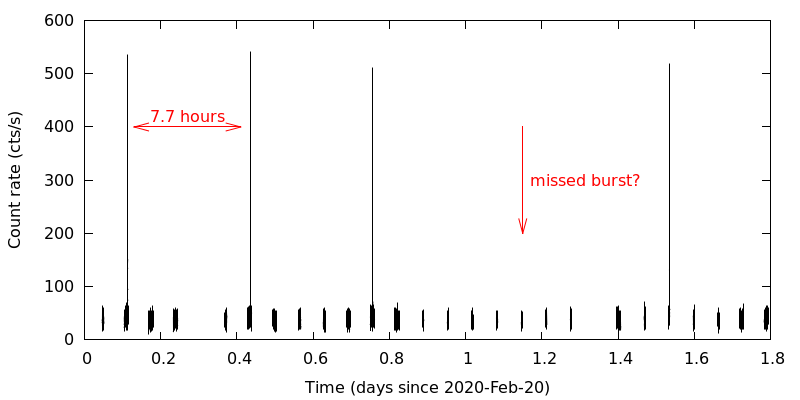NICER / ISS Science Nugget
for February 27, 2020
NICER detects Type 1 X-ray bursts from XTE J1739-285
The neutron star X-ray transient XTE J1739-285 is a known source of type I
X-ray bursts: short-lived thermonuclear explosions on the surface of a neutron
star that burn through the entire hydrogen atmosphere of the star in a matter of
seconds. Sometimes this burning process proceeds asymmetrically, giving rise to
coherent oscillations in the emission that reveal the rotation rate of the
star. It has been claimed that XTE J1739 shows such oscillations at a period
of 0.9 milliseconds – which would makes this source the fastest spinning
neutron star known. Lacking a statistically robust sample, however, this claim
has never been confirmed.
On February 13, it appeared that XTE J1739 entered a new outburst phase. NICER
quickly began monitoring this source and found the intensity slowly rising,
indicating that increasing amounts of fresh hydrogen are falling on the stellar
surface. On February 20, the conditions were just right for this hydrogen to
ignite in a thermonuclear X-ray burst. It takes a few hours for the atmosphere
to recover, and indeed, approximately every 8 hours a new X-ray burst was observed.
Clearly, to collect a large sample of such recurring X-ray bursts, we need regular
and high-cadence monitoring. We probably missed just one burst in this train of
events, reflecting NICER's capability in this respect.

Figure:
Black vertical bars indicate the X-ray brightness (number of photons
in 1 second intervals) of XTE J1739 since the start of its most recent, and ongoing,
outburst. The tallest bars represent Type I (thermonuclear) bursts, which appear
to be recurring at intervals of 7.7 hours. NICER has so far detected 8 such bursts.
Detailed analysis of these bursts is currently under way, led by Dr. Peter
Bult at NASA's Goddard Space Flight Center.
<< Previous
Main Index
Next >>